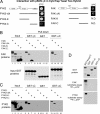alpha- and gamma-Protocadherins negatively regulate PYK2
- PMID: 19047047
- PMCID: PMC2631960
- DOI: 10.1074/jbc.M807417200
alpha- and gamma-Protocadherins negatively regulate PYK2
Abstract
Genetic studies demonstrate that gamma-protocadherins (PCDH-gamma) are required for the survival and synaptic connectivity in neuronal subpopulations of the central nervous system. However, the intracellular signaling mechanisms for PCDH-gamma are poorly understood. Here, we show that PCDH-gamma binds two tyrosine kinases, PYK2 and focal adhesion kinase (FAK), and interaction with PCDH-gamma inhibits kinase activity. Consistent with this, PYK2 activity is abnormally up-regulated in the Pcdh-gamma-deficient neurons. Overexpression of PYK2 induces apoptosis in the chicken spinal cord. Thus, negative regulation of PYK2 activity by PCDH could contribute to the survival of subsets of neurons. Surprisingly, we found that PCDH-alpha interacts similarly with PYK2 and FAK despite containing a distinct cytoplasmic domain. In neural tissue, PCDH-gamma, together with PCDH-alpha, forms functional complexes with PYK2 and/or FAK. Therefore, the identification of common intracellular effectors for PCDH-gamma and PCDH-alpha suggests that dozens of protocadherins generated by Pcdh-alpha and Pcdh-gamma gene clusters can converge different extracellular signals into common intracellular pathways.
Figures








References
Publication types
MeSH terms
Substances
Grants and funding
LinkOut - more resources
Full Text Sources
Molecular Biology Databases
Miscellaneous

